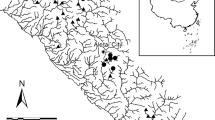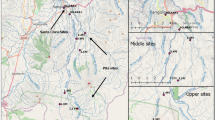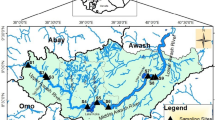Abstract
Biological indicators are being increasingly used to rapidly monitor changing river quality. Among these bioindicators are macroinvertebrates. A short-coming of macroinvertebrate rapid assessments is that they use higher taxa, and therefore lack taxonomic resolution and species-specific responses. One subset of invertebrate taxa is the Odonata, which as adults, are sensitive indicators of both riparian and river conditions. Yet adult Odonata are not necessarily an umbrella taxon for all other taxa. Therefore, we investigated whether the two metrics of aquatic macroinvertebrate higher taxa and adult odonate species might complement each other, and whether together they provide better clarity on river health and integrity than one subset alone. Results indicated that both metrics provide a similar portrait of large-scale, overall river conditions. At the smaller spatial scale of parts of rivers, Odonata were highly sensitive to riparian vegetation, and much more so than macroinvertebrate higher taxa. Odonate species were more sensitive to vegetation structure than they were to vegetation composition. Landscape context is also important, with the odonate assemblages at point localities being affected by the neighbouring dominant habitat type. Overall, benthic macroinvertebrates and adult Odonata species provide a highly complementary pair of metrics which together provide large spatial scale (river system) and small spatial scale (point localities) information on the impact of stressors such as riparian invasive alien trees. As adult Odonata are easy to sample and are sensitive to disturbance at both small and large spatial scales, they are valuable indicators for rapid assessment of river condition and riparian quality.
Similar content being viewed by others
References
Brown CA (2001) A comparison of several methods of assessing river condition using benthic macroinvertebrate assemblages. Afr J Aquat Sci 26:135–147
Chovanec A, Waringer J (2001) Ecological integrity of river floodplain systems assessment by dragonfly surveys (Insecta: Odonata). Regulated Rivers: Res Manage 17:493–507
Clark TE, Samways MJ (1996) Dragonflies (Odonata) as indicators of biotope quality in the Kruger National Park, South Africa. J Appl Ecol 33:1001–1012
Clark KR, Warwick RM (2001) Change in marine communities: an approach to statistical analyses and interpretation. 2nd edn. Primer-E, Plymouth, UK
Corbet PS (1999) Dragonflies: behaviour and ecology of Odonata. Harley, Colchester, UK
Dallas HF (1997) A preliminary evaluation of aspects of SASS (South African Scoring System) for the rapid bioassessment of water quality in rivers, with particular reference to the incorporation of SASS in a national biomonitoring programme. South Afr J Aquat Sci 23:79–94
Davies B, Day J (1998) Vanishing waters. University of Cape Town Press, Cape Town
Dickens CWS, Graham PM (2002) The South Africa Scoring System (SASS) version 5 rapid bioassessment method for rivers. Afr J Aquat Sci 27:1–10
Dovciak AL, Perry JA (2002) In search of effective scales for stream management: does agroecoregion, watershed, or their intersection best explain the variance in stream macroinvertebrate communities? Environ Manage 30:365–377
Eyre MD, Ball SG, Foster GN (1986) An initial classification of the habits of aquatic Coleoptera in North-east England. J Appl Ecol 23:841–852
Gerber A, Gabriel MJM (2002) Aquatic invertebrates of southern Africa. Illustrations. Institute for Water Quality Studies. Department of Water Affairs and Forestry, Pretoria
Hawkins CP, Norris RH, Houge JN, Feminella JW (2000) Development and evaluation of predictive models for measuring the biological integrity of streams. Ecol Appl 10:1456–1477
Hawking JH, New TR (2002) Interpreting dragonfly diversity to aid in conservation assessment: lessons from the Odonata assemblage at Middle Creek, north-eastern Victoria, Australia. J␣Insect Conserv 6:171–178
Heino J, Paavola R, Virtanen R, Muotka T (2005) Searching for biodiversity indicators in running waters: do bryophytes, macroinvertebrates, and fish show congruent diversity patterns? Biodivers Conserv 14:415–428
Karr JR (1991) Biological integrity: a long-neglected aspect of water research management. Ecol Appl 1:66–84
Karr JR, Chu EW (1999) Restoring life in running waters: better biological monitoring. Island Press, Washington, DC
Kinvig RG, Samways MJ (2000) Conserving dragonflies (Odonata) along streams running through commercial forestry. Odonatologica 29:195–208
Lammert M, Allen JD (1999) Assessing biotic integrity of streams: effects of scale in measuring the influence of land use/cover and habitat structure on fish and macroinvertebrates. Environ Manage 23:257–270
Mancini L, Formichetti P, Anselmo A, Tancioni L, Marchini S, Sorace A (2005) Biological quality of running waters in protected areas: the influence of size and land use. Biodivers Conserv 14:351–364
Metcalf-Smith JL (1994) Biological water-quality assessment of rivers: use of macroinvertebrate communities. In: Calow P, Petts GE (eds) The rivers handbook, hydrological and ecological principles. vol. 2. Blackwell, Oxford, pp 144–170
Morley SA, Karr JR (2002) Assessing and restoring the health of urban streams in the Puget sound basin. Conserv Biol 16:1498–1509
Norris RH, Norris KH (1995) The need for the biological assessment of water quality: Australian perspective. Aust J Ecol 20:1–6
Osborn R, Samways MJ (1996) Determinants of adult dragonfly assemblage patterns at new ponds in South Africa. Odonatologica 25:49–58
Pinhey E (1984) A survey of the dragonflies (Odonata) of South Africa Part 1. J Entomol Soc Southern Afr 47:147–188
Rogers K, Biggs H (1999) Integrating indicators, endpoints and value systems in strategic management of the rivers of the Kruger National Park. Freshwater Biol 41:439–451
Rosenberg DK, Noon BR, Meslow EC (1997) Biological corridors: form, function and efficacy. BioScience 47:677–687
Rosenberg DM, Resh VH (eds) (1993) Freshwater biomonitoring and benthic macroinvertebrates. Chapman & Hall, New York, London, p 488
Samways MJ (1993) Dragonflies (Odonata) in taxic overlays and biodiversity conservation. In:␣Gaston KJ, New TR, Samways MJ (eds) Perspectives on insect conservation. Intercept, Andover, UK, pp 111–123
Samways MJ (1999) Diversity and conservation status of South African dragonflies (Odonata). Odonatalogica 28:13–62
Samways MJ, Caldwell PM, Osborn R (1996) Spatial patterns for dragonflies (Odonata) as indicators for design of a conservation pond. Odonatologica 25:157–166
Samways MJ, Steytler NS (1996) Dragonfly (Odonata) distribution patterns in urban and forest landscapes, and recommendations for riparian management. Biol Conserv 78:279–288
Samways MJ, Taylor S (2004) Impacts of invasive alien plants on Red-Listed South African dragonflies (Odonata). South Afr J Sci 100:78–80
Schutte G, Reich M, Plachter H (1997) Mobility of the rheobiont damselfly Calopteryx splendens (Harris) on fragmented habitats (Zygoptera: Calopterygidae). Odonatologica 26:317–327
Smith MJ, Kay WR, Edward PJ, Papas K, Richardson STJ, Simpson JC, Pinder AM, Carle DJ, Horwitz PHJ, Davids JA, Yung FH, Norris RH, Halse SA (1999) AusRivAS: using macroinvertebrates to assess ecological condition of rivers in Western Australia. Freshwater Biol 41:269–282
Stewart DAB, Samways MJ (1998) Conserving dragonfly (Odonata) assemblages relative to river dynamics in an Africa savanna game reserve. Conserv Biol 12:683–692
Suh A, Samways MJ (2005) Significance of temporal changes in designing a reservoir for conservation of dragonfly diversity. Biodivers Conserv 14:165–178
ter Braak CJF (1986) Cononical correspondence analysis: a new eigenvector technique for multivariate direct gradient analysis. Ecology 65:1167–1179
Wright JF, Moss D, Armitage PD, Furse MT (1984) A preliminary classification of running-water sites in Great Britain based on macro-invertebrate species and the prediction of community type using environmental data. Freshwater Biol 14:221–256
Yoder CO, Ranking ET (1995) Biological response signatures and the area of degradation value: new tools for interpreting multimetric data. In: Davis WS, Simon TP (eds) Biological assessment and criteria: tools for water resources planning and decision making. Lewis, Boca Raton Florida, pp 263–286
Acknowledgements
Financial support was from the Working for Water Programme.
Author information
Authors and Affiliations
Corresponding author
Rights and permissions
About this article
Cite this article
Smith, J., Samways, M.J. & Taylor, S. Assessing Riparian Quality Using Two Complementary Sets of Bioindicators. Biodivers Conserv 16, 2695–2713 (2007). https://doi.org/10.1007/s10531-006-9081-2
Received:
Accepted:
Published:
Issue Date:
DOI: https://doi.org/10.1007/s10531-006-9081-2




